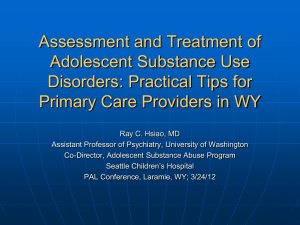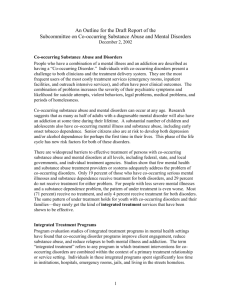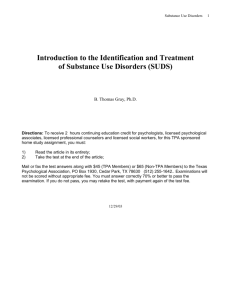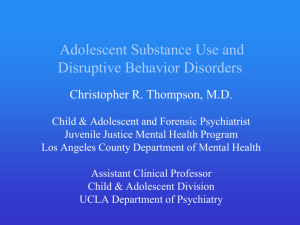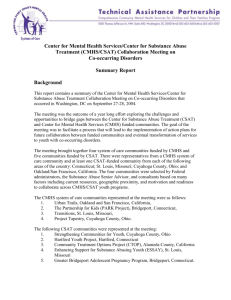028-036 Alcohol 12/28/11 10:36 PM Page 028
advertisement
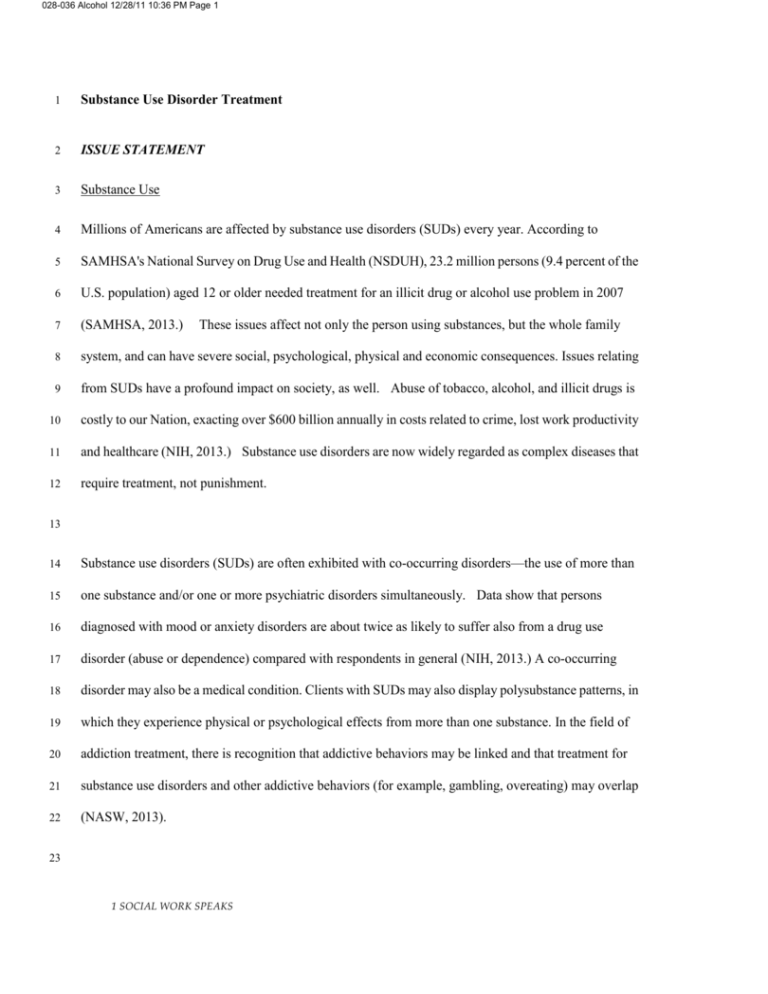
028-036 Alcohol 12/28/11 10:36 PM Page 1 1 Substance Use Disorder Treatment 2 ISSUE STATEMENT 3 Substance Use 4 Millions of Americans are affected by substance use disorders (SUDs) every year. According to 5 SAMHSA's National Survey on Drug Use and Health (NSDUH), 23.2 million persons (9.4 percent of the 6 U.S. population) aged 12 or older needed treatment for an illicit drug or alcohol use problem in 2007 7 (SAMHSA, 2013.) 8 system, and can have severe social, psychological, physical and economic consequences. Issues relating 9 from SUDs have a profound impact on society, as well. Abuse of tobacco, alcohol, and illicit drugs is 10 costly to our Nation, exacting over $600 billion annually in costs related to crime, lost work productivity 11 and healthcare (NIH, 2013.) Substance use disorders are now widely regarded as complex diseases that 12 require treatment, not punishment. These issues affect not only the person using substances, but the whole family 13 14 Substance use disorders (SUDs) are often exhibited with co-occurring disorders—the use of more than 15 one substance and/or one or more psychiatric disorders simultaneously. Data show that persons 16 diagnosed with mood or anxiety disorders are about twice as likely to suffer also from a drug use 17 disorder (abuse or dependence) compared with respondents in general (NIH, 2013.) A co-occurring 18 disorder may also be a medical condition. Clients with SUDs may also display polysubstance patterns, in 19 which they experience physical or psychological effects from more than one substance. In the field of 20 addiction treatment, there is recognition that addictive behaviors may be linked and that treatment for 21 substance use disorders and other addictive behaviors (for example, gambling, overeating) may overlap 22 (NASW, 2013). 23 1 SOCIAL WORK SPEAKS 028-036 Alcohol 12/28/11 10:36 PM Page 2 24 Treatment 25 Scientific research since the mid–1970s shows that treatment can help patients addicted to drugs stop 26 using, avoid relapse, and successfully recover their lives (NIH, 2013.) There is a growing emphasis in 27 the professional fields working with clients with SUDs on using short-term, limited interventions. 28 However, many clients who are dependent on substances require longer term interventions that 29 recognize that substance use can be a chronic disorder— one that includes relapse and may not resolve 30 for months or even years (NASW, 2013). 31 32 Consistent with a change in conceptualization in the Diagnostic and Statistical Manual of Mental 33 Disorders (5th edition) (DSM–5) (American Psychiatric Association, 2012), addiction is no longer 34 viewed as an “either/or” phenomenon. That is, substance use is no longer dichotomized into separate 35 categories of dependence and abuse; rather, is viewed as existing along a continuum. This paradigm shift 36 opens up the possibility for larger numbers of clients meeting the criteria of having substance use 37 disorders and being eligible for treatment (NASW, 2013). 38 39 Related to this shift, harm reduction is increasingly emphasized today in federal funding and treatment 40 services. The harm reduction approach is consistent with the social work value of self-determination and 41 “meeting the client where the client is.” Harm reduction principles are applied in the interests of 42 promoting public health—for example, to reduce homelessness or prevent the contraction of HIV/AIDS 43 in populations affected by substance use disorders (NASW, 2013). 44 Barriers to Treatment 45 Most people with SUDs do not receive adequate treatment. An estimated 20.8 million persons (8.4 percent of the 46 population aged 12 or older) needed treatment for an illicit drug or alcohol use problem but did not receive it 028-036 Alcohol 12/28/11 10:36 PM Page 3 47 (SAMHSA, 2013.) This is due to a variety of reasons, including: 48 49 lack of available service provision due to shortage of inpatient beds. 50 financial resources as managed care providers restrict the length of inpatient treatment stays. 51 willingness to engage in treatment as resistance to treatment is a main factor of the nature of substance use. 52 53 social stigma and consequences of seeking treatment as being labeled with substance use disorders can affect a person’s social standing including child custody and employment. 54 55 56 POLICY STATEMENT 57 NASW supports and advocates for policies that promote: 58 evidence-informed methods of prevention, treatment and recovery. increased access to affordable services and include treatment coverage under health care reform 59 60 requirements. 61 62 63 mandatory inclusion of behavioral health parity regarding health care coverage. the elimination of stigmatizing language and labels and the promotion of respectful, 64 65 supportive, strengths-based language regarding SUD issues. 66 67 68 69 the use of a holistic approach considering all treatment options to determine the best course of treatment for the individual including, but not limited to clinical intervention, medication therapy, 3 SOCIAL WORK SPEAKS 028-036 Alcohol 12/28/11 10:36 PM Page 4 harm-reduction approaches, and alternatives to incarceration. 70 71 72 access for individuals with SUDs and co-occurring mental, physical, and other disorders to receive treatment in an integrated, supportive manner. 73 74 75 comprehensive treatment in addressing compounding issues a person with SUDs may 76 experience such as health, employment, family, housing, legal, and other problems that may impede 77 recovery. 78 79 comprehensive, ongoing training and development of social worker’s knowledge and skills in 80 culturally competent, evidence-informed methods of assessment, intervention, and evaluation of 81 prevention and treatment approaches relating to substance use disorders. 82 83 84 the collaboration between social workers and other professionals, organizations, etc. to enhance the research base of effective treatment methods for best practices. 85 86 References 87 American Psychiatric Association (2012). DSM–5 development: R substance use disorder. Retrieved from 88 http://www.dsm5.org/proposedrevision/pages/proposedrevision.aspx?rid=431 89 National Association of Social Workers (2013). NASW Standards for Social Work Practice with Clients with 90 Substance Use Disorders. Washington DC: NASW Press. 91 National Institute of Health (2013). National Institute on Drug Abuse: The Science of Drug Abuse and Addiction. 92 Retrieved from http://www.drugabuse.gov/. 028-036 Alcohol 12/28/11 10:36 PM Page 5 93 Substance Abuse and Mental Health Services Administration (2013). Data Outcomes and Quality: National 94 Survey on Drug Use and Health (NSDUH). Retrieved from http://www.samhsa.gov/data/NSDUH.aspx. 5 SOCIAL WORK SPEAKS








